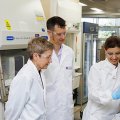Australia’s SCRAMSPACE hypersonic scramjet could launch as early as Monday, with ideal weather conditions predicted.
The $14 million three-year data-collecting research project led by The University of Queensland is scheduled to launch between September 15 and 21 at Andøya Rocket Range in Norway.
SCRAMSPACE Director and Chair for Hypersonics at UQ Professor Russell Boyce said, with sunny weather predicted for nearly the entire seven-day launch window, there was a high chance the team could launch early in the week.
“The scramjet and the rocket motors are sitting on the launcher looking magnificent, and we have a full launch rehearsal planned for Sunday to ensure the team are ready for the big day,” Professor Boyce said.
“All going well, we expect to launch into the sunshine on Monday,” he said.
Scramjets are air-breathing engines that travel at hypersonic speeds.
The $14 million SCRAMSPACE hypersonic scramjet (Scramjet-based access to space-based technologies) is capable of reaching speeds of 8600km/h.
The data collected at such speeds will give insights into hypersonic physics, hypersonic combustion, performance of materials and components, and how these vehicles will fly in future.
These insights could, for example, offer solutions to deliver satellites into orbit more efficiently.
“As part of the Australian Space Research Program, this project supports Australia’s access to space, and helps build the talent pool of engineers, scientists and specialists we need to do it,” Professor Boyce said.
The international research team is made up of 13 partners and sponsors (below).
Australia’s Defence Science and Technology Organisation DSTO is a key partner on the launch, providing major support in the design, development and testing of the payload, and coordinating the launch campaign.
DSTO Research Leader in Applied Hypersonics, Dr Allan Paull, said the Australian research project had the potential to answer aerospace challenges on behalf of the international community.
“Since Queensland built a shock tunnel and expansion tubes in the early 1980s, we have been able to test at super high-speeds,” Dr Paull said.
“Hypersonic ground testing-coupled with flight testing is something quite unique that Australia is able to offer, which has led us to be considered a world-leader in hypersonics research.”
The scramjet will be launched at Andoya Rocket Range, 300km north of the Arctic Circle.
On launch, the spacecraft will reach an altitude of 320 kilometres, powered by a two-stage rocket. After leaving the atmosphere, the scramjet vehicle will separate from the rocket and, using small thrusters, orient itself for the re-entry.
During the return flight, gravity will accelerate the vehicle to Mach 8 – about 8600km/h. This is when the team will collect the most valuable data, before the scramjet self-destructs over the sea as planned.
To inspire and expose more people to the basic nature of hypersonic science, UQ has also included a hypersonics course among its first four Massive Open Online Courses, offered free on the internet through the edX consortium.
Media, images, interviews and access to launch footage: Janelle Kirkland, UQ Communications, +47 4763 4282 (Norway), +61 7 3346 0561 (Australia), or j.kirkland@uq.edu.au
Pre-launch footage and photos available here.
Post-launch footage and photos will be made available to media following the launch on the website.
Interviews are also available via Skype on request.
Website: http://hypersonics.mechmining.uq.edu.au/scramspace1 Facebook page: https://www.facebook.com/ScramspaceOne?fref=ts Twitter: https://twitter.com/ScramspaceOne Hypersonic MOOCs course: http://uqx.uq.edu.au/hypersonics.
About the SCRAMSPACE project
SCRAMSPACE is the first and largest project funded by the Australian Space Research Program. It builds on Australia's world-class hypersonics heritage, and its core objective is to build capacity and capability, in particular a talent pool, for the Australian space and aerospace industry.
This is achieved partly by means of the Mach 8 flight experiment, for which a team of exceptional young scientists and engineers has been assembled, and partly through extensive ground-based research involving many PhD students at UQ and partner universities.
The design, development and testing of the flight experiment payload has been led and performed by UQ with major support from Australia's Defence Science and Technology Organisation (DSTO), who are also coordinating the launch campaign.
The University of New South Wales (UNSW) and the Italian Aerospace Research Center (CIRA) have provided additional onboard experiments, while the German Aerospace Center (DLR) and industry partners BAE Systems and Teakle Composites have played key roles with provision of flight hardware, pre-flight testing and launching the rocket (DLR).
Other partners in the program, involved in the ground-based aspects, are the University of Southern Queensland, University of Minnesota, Japanese Aerospace Exploration Agency (JAXA), AIMTEK, and the Australian Youth Aerospace Association.
About The University of Queensland (UQ)
The University of Queensland, Australia, is one of the world’s premier teaching and research institutions. It is consistently ranked in the top 100 in the four leading independent global rankings. With more than 45,000 students and 7500 staff, UQ’s teaching is informed by research, and spans six faculties and eight research institutes.













